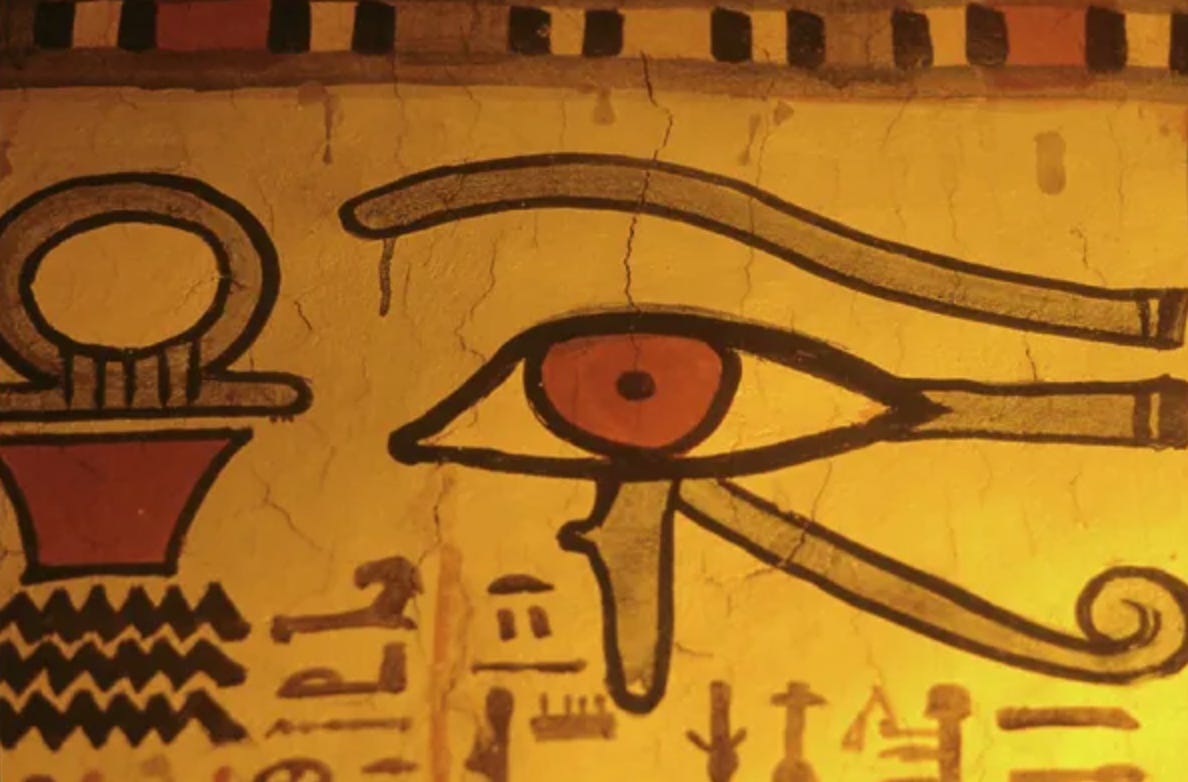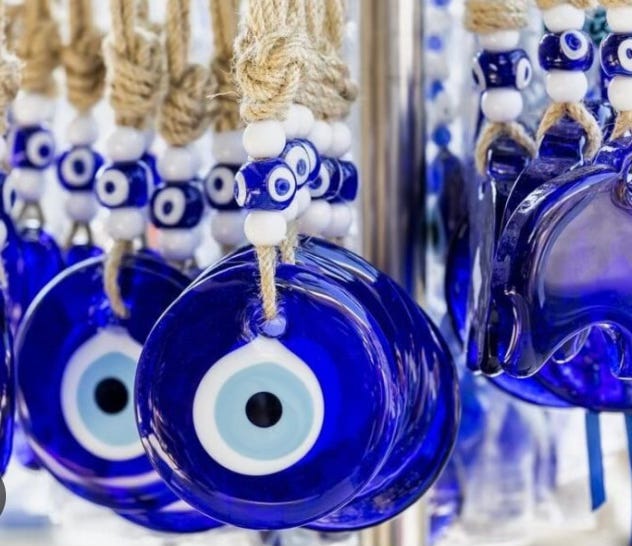Evil Eye
A mystical stare that spans millennia - unveiling the hidden force of the evil eye in Greece’s most iconic superstition.
Evil eye
I'll keep you by my side
This evil eye
Has powers I require
Your strange magic may
Keep me from harm's way
I've witnessed, eye
It’s mystery at play
- Roisin Murphy, Evil Eyes
I remember when I first heard this song. I’ve been a long time fan of Roisin Murphy’s - first with her group Moloko, and then with her solo creations. She’s an extraordinary artist and blends an eclectic mix of art, fashion and music to create authentic experiences. So when I first heard her song Evil Eyes, I was instantly drawn to it - not just audibly, but lyrically as well.
Evil eyes are something deeply embedded in my Greek cultural heritage. Murphy is a proud Irish woman however, even for her, there was something mystical and powerful about this symbol.
The evil eye - known as μάτι (mati) in Greek - is one of the most enduring symbols of folk belief, superstition, and spiritual protection in Mediterranean and Middle Eastern cultures. Deeply embedded in Greek culture, the concept of the evil eye reflects a complex interplay of mythology, religion, history, and everyday social customs. Though often dismissed as superstition, its symbolic power and continued presence in daily Greek life speak to a much older, and more universal, human concern: the vulnerability of good fortune to envy.
Growing up in a Greek family, the mati was more than folklore though; it was part of the air we breathed. It hung above our doorways, stitched into the blue-threaded komboskini (prayer bracelets) blessed by monks, and clinked softly against baptismal crosses at every baby’s christening. When a new child was born, a mati was often the first gift they received - an unspoken way of saying, “You are loved, but let’s keep envy at bay.” Even now, if someone compliments a baby without saying “ftou sou” (a protective spit-like phrase), the older women in the room will exchange knowing glances and gently whisper a prayer to lift any unintended curse.
I remember the first time I placed my daughter’s mati on her - the smallest of pins held the little blue eye together and it was fastened onto her singlet. There was also another one pinned beneath her pillow as she got a little older. Whilst not overtly religious in any way, I somehow felt this was an important talisman. This sounds superstitious of course, but for many Greeks, this is part and parcel of Greek life.
The origins of the evil eye trace back to ancient Greece, where early philosophical and literary sources reference a malevolent force transmitted through the gaze. The pre-Socratic philosopher Empedocles, for instance, proposed that the eyes emitted invisible rays that could influence the world - a concept that laid early groundwork for understanding how the gaze might harm or protect.
In classical Greek literature, the idea of the evil eye appears in the works of Plutarch and Hesiod, among others. Hesiod alluded to the envy of the gods toward mortals who prospered, suggesting that misfortune was often divine punishment or a cosmic correction for excessive fortune. Plutarch, in particular, explored the idea that the eyes could be sources of harmful emanations, especially when charged with envy or malice. Plutarch writes about a conversation where Mestrius Florus is discussing the evil eye. It begins with a group of educated thinkers dismissing the evil eye as superstition, unworthy of serious debate. However, Florus challenges this view, calling for a thoughtful discussion grounded in observable evidence, or at least what was considered such at the time. He introduces a number of documented cases and encourages the group to explore rational explanations for the phenomenon, giving us a rare insight into how people in antiquity tried to make sense of the evil eye using logic and philosophy. Early in the dialogue, attention turns to the physical nature of the eye itself. Drawing from the extramission theory - the idea that the eyes emit particles or rays - Plutarch builds a case for the eye as a powerful transmitter. He argues that all human bodies give off subtle emissions through scent, breath, and sound, but the eyes, he claims, are the most active of these channels. Through vision, we don’t just see; we feel, react, and are emotionally moved. The pleasure lovers experience when gazing at each other is used as an example of how the eyes can influence others. If we can be affected through what we see, then it follows that we can also affect others through our gaze. The discussion then shifts from the physical to the emotional dimension. Plutarch suggests that strong emotions - especially envy - have tangible effects on the body. Intense jealousy can alter a person’s appearance and well-being. In this view, envy builds up internally, particularly in the mind, and because of the mind’s close connection to the eyes, it can be unleashed simply through a glance. The evil eye, then, becomes a projection of inner turmoil - an outward expression of hidden envy, made dangerous through sight.
The mythological Gorgon Medusa - whose gaze turned men to stone - embodies the destructive power of sight. Her eyes became symbolic of a gaze so potent that it could bring instant ruin, offering an early archetype of the evil eye’s danger. Ironically, her severed head later became a talisman for protection, often engraved on shields or doorways to ward off evil - an early iteration of protective symbolism.
Though the evil eye is rooted in pre-Christian traditions, it was seamlessly absorbed into Orthodox Christianity in the Greek world. Rather than dismiss it as pagan, the Church contextualised the evil eye as a manifestation of envy - a deadly sin - and prescribed prayers and blessings (xematiasma) to counteract its effects. To this day, Greek Orthodox priests or devout elders may perform these rituals to lift the curse of the evil eye. So many times I was ‘de-eyed’ - with elders using olive oil, prayer and some rather bizarre rituals. If anyone found themselves yawning and sleepy despite ample rest and sleep, suffering from intense headaches or migraines, or just feeling down and out, the blame squarely lay on the eye - someone had definitely eyed you or you were matiasmeni.
.It is thought that the eye motif was first introduced by the renowned Ancient Greek vase painter Exekias, and his infamous Dionysus cup. The primary function of the painted eyes was of course apotropaic; as the drinker raised the vessel the exaggerated eyes would protect them from evil spirits, and also perhaps from the envious gaze of other guests. Eye-cups were not just protective talismans however, as they transformed into a mask when the drinker raised it to his lips, keeping guard over the drinker even when their vision became impaired.
This same reverence for the eye as a conduit of unseen forces can be seen across ancient wisdom traditions: the Eye of Horus in Egyptian mythology symbolised protection, health, and divine insight. In Hermetic thought, the eye often symbolises higher awareness, divine vision, and the inner illumination of truth. This is closely connected to the idea of the third eye - a metaphysical concept representing inner sight or spiritual insight. To “see” in Hermetic terms is to perceive not only the physical world but also the hidden principles behind it, the patterns of nature, and the divine order that governs all things.
The All-Seeing Eye, for example, a motif found in Hermetic texts and later adapted into Western esoteric and Masonic traditions, represents the universal mind or Nous - a divine intelligence that observes and governs creation. This idea parallels the Egyptian Eye of Horus, which symbolised healing, protection, and cosmic insight.
Within this philosophical framework, the eye is not merely symbolic - it is a vehicle of intention and energy. Hermeticism teaches that all things in the universe are connected through vibrations and mental energy (The All is Mind being a core tenet). This gives the gaze, especially when charged with intense emotions like envy or malice, the potential to act as a transmitter of harmful vibrations.
This is where the idea of the evil eye finds resonance. While Hermetic texts don’t directly discuss casting spells through jealousy-laden glances, they do affirm that mental and emotional states can manifest physically and spiritually. A gaze filled with envy, then, may disrupt the balance of energies in another person, especially if that person is spiritually vulnerable or energetically receptive. In this way, the folk understanding of the evil eye aligns with Hermetic principles: thoughts and intentions- especially negative ones - are not inert. They move, they influence, and they shape the world.
While the evil eye is rooted in folk belief, Hermetic philosophy provides a deeper metaphysical framework that helps explain why this concept has endured across time and culture. It treats the eye not just as a physical organ, but as a bridge between inner consciousness and outer influence - a channel through which both enlightenment and harm can pass. In this light, the evil eye becomes not merely superstition, but a reminder of the power of thought, intention, and the unseen forces that shape our lives.

In modern Greece, the evil eye remains a potent force in everyday life. Blue glass amulets - called "matakia" - are commonly worn as jewellery or hung in homes, cars, or businesses to absorb or deflect envious energy. The colour blue, historically associated with spiritual purity and divine favour, is believed to be particularly effective against malevolent forces.
Modern thinkers like Dr. Jack Kruse echo this ancient understanding, though in scientific language. His work emphasises how light entering the eye - specifically natural sunlight - plays a critical role in regulating our biology. He highlights how our eyes are not just passive receptors but active gateways, allowing sunlight to reset circadian rhythms, fuel mitochondrial function, and even influence hormonal cascades. According to Kruse, artificial blue light, especially without the balancing presence of red or infrared light, disrupts these vital processes and can cause systemic biological damage, particularly through the destruction of a photoreceptor protein called melanopsin found in the retina and skin.
This intersection is fascinating: ancient cultures perceived the eye as a powerful transmitter and receiver of energy - capable of bestowing harm or healing - while modern science is uncovering that the eye indeed plays a pivotal role in the body’s energy regulation. The evil eye, then, may have been an early, intuitive understanding of how profoundly light and gaze affect us. Whether through the esoteric language of the third eye or the biological language of light and mitochondria, the message is clear: the eyes are sacred, powerful instruments - bridges between the external world and the inner workings of our body and soul.
The evil eye is everywhere in Greek life - a thread woven through faith, family, and history. It’s in the bracelets tied by monks, in the keychains of taxis, in the corners of kitchens. But why do we still hold on to it so tightly? Maybe it’s because the mati offers something ancient and comforting: the belief that in a world full of unseen forces - jealousy, admiration, chance - we have at least one symbol to keep us grounded and protected. It’s more than a charm; it’s a piece of who we are.








